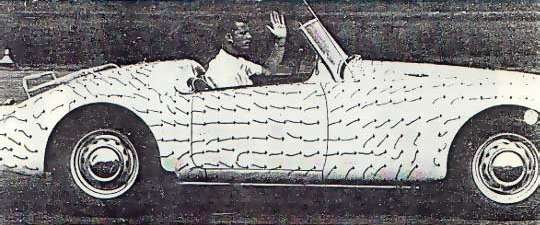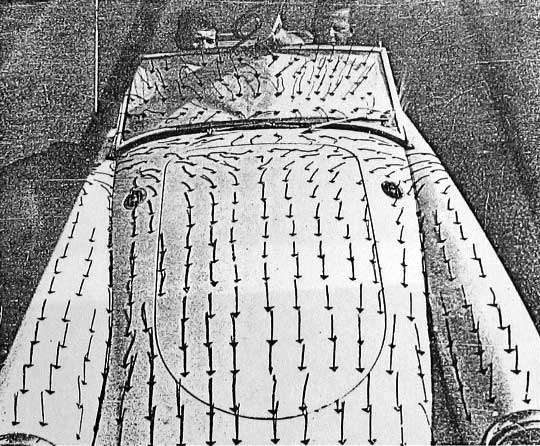The MGA With An Attitude
WIND TUNNEL TESTING of the MGA - HS-130
"Streamlining" from Sports Car Graphic, April 1964

A series of articles on streamlining by Walter Korff appeared in Sports Car Graphic in July, September and November of 1962. As a result Korff was nomination to a Society of Automotive Engineer’s Board that presented several papers on streamlining to the Industry. These teste were done at the Aerophysics Lab of Mississippi State University. One of their first automotive projects was to take a standard production sports car (an MGA) and examine it for aerodynamic problems (other than drag reduction). The result was detailed in a paper by J.J. Cornish III, head of the Department, who's conclusions were as follows:

1- The MGA grill alters the course of the air flow entering the front off the car in such a manner as to deflect it away from the entrance to the carburettor air duct and heater duct.
2- The high-velocity air passing beneath the car reduces the pressure within the engine compartment to the extent that it is lower than the pressure on the hood.
3- The air outlets on the hood are located in a position at which air pressure outside the hood is greater than inside and results in air flowing in rather than out.
4 - A strong stagnation vortex exists at the base of the windshield, disturbing the flow and giving rise to problems with rain and the operation of the windshield washers.
5 - A strong reversed flow of air enters the cockpit from behind (with the top down) causing severe buffeting in that area.
6- Insufficient ventilation or circulation is provided near the bottom of the cockpit causing high temperatures to develop in that area after protracted driving.
7- The disturbed flow beneath the car, joining with the flow from above, produces a large wake of entrained flow behind.
8- The noise level due to flow separation and other aerodynamic sources is particularly high.
As you can see, there are other important aerodynamic factors to automotive design aside from basic streamlining. Many other production cars share the MGA’s ills in this respect. Correction is, in some instances, restricted by other requirements, but it's easy to conclude that little - if any - consideration was given to these aspects in the design of the subject vehicle, yet both performance and passenger comfort could have been noticeably better if it had.
We hope to encourage Mr. Cornish’s department to undertake studies of higher-performance coupes in the near future. Constructors are currently running into stability problems above 175 mph and conclusions of knowledgeable wind-tunnel studies might make a major contribution to the sport.
|

